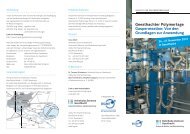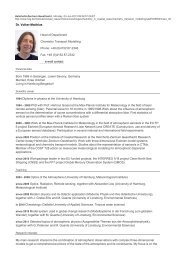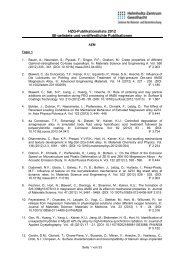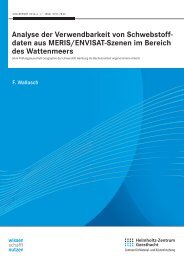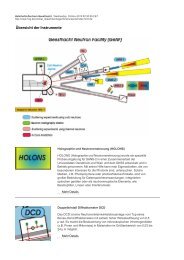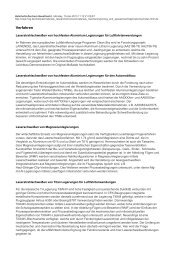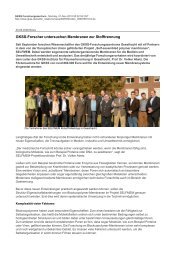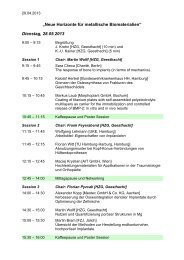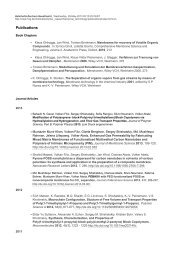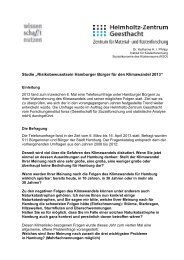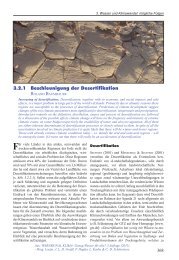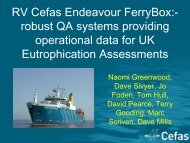Landfills and waste water treatment plants as sources of ... - GKSS
Landfills and waste water treatment plants as sources of ... - GKSS
Landfills and waste water treatment plants as sources of ... - GKSS
Create successful ePaper yourself
Turn your PDF publications into a flip-book with our unique Google optimized e-Paper software.
STUDY 1: LANDFILLS AS SOURCES<br />
4. Study 1: <strong>L<strong>and</strong>fills</strong> <strong>as</strong> <strong>sources</strong> <strong>of</strong> polyfluorinated compounds,<br />
polybrominated diphenyl ethers <strong>and</strong> synthetic musk fragrances to<br />
ambient air<br />
4.1 Introduction<br />
According to the German Ordinance on Compatible Storage <strong>of</strong> W<strong>as</strong>te from Human<br />
Settlements <strong>and</strong> on Biological-Treatment Facilities (Abfallablagerungsverordung, AbfAblV) a<br />
l<strong>and</strong>fill is defined <strong>as</strong> “<strong>w<strong>as</strong>te</strong>-management facility for the storage <strong>of</strong> <strong>w<strong>as</strong>te</strong> above the earth's<br />
surface (above-ground)”(AbfAblV 2001). In general, l<strong>and</strong>fills contain a variety <strong>of</strong> different<br />
types <strong>of</strong> <strong>w<strong>as</strong>te</strong> including household <strong>w<strong>as</strong>te</strong> <strong>and</strong> <strong>w<strong>as</strong>te</strong> from industrial <strong>sources</strong> <strong>and</strong> products.<br />
Household <strong>w<strong>as</strong>te</strong> represents two-thirds <strong>of</strong> the municipal solid <strong>w<strong>as</strong>te</strong> stream. Almost 70 % <strong>of</strong><br />
municipal solid <strong>w<strong>as</strong>te</strong> is disposed to l<strong>and</strong>fills (OECD 2001). In particular, sanitary l<strong>and</strong>fills<br />
accumulate huge quantities <strong>of</strong> a wide variety <strong>of</strong> consumables, including general <strong>and</strong><br />
hazardous <strong>w<strong>as</strong>te</strong>s, electric <strong>and</strong> electronic equipment <strong>and</strong> compost (St-Am<strong>and</strong> et al. 2008).<br />
Since the European Commission Directive 99/31/EC which constituted the cl<strong>as</strong>sification <strong>and</strong><br />
separation <strong>of</strong> <strong>w<strong>as</strong>te</strong> prior to the deposit, <strong>w<strong>as</strong>te</strong> <strong>treatment</strong> is strongly regulated in the European<br />
Union. In Germany for example, the Ordinance on <strong>L<strong>and</strong>fills</strong> <strong>and</strong> Long-Term Storage<br />
Facilities (Deponieverordnung, DepV), dem<strong>and</strong>s separation <strong>and</strong> pre-<strong>treatment</strong> <strong>of</strong> <strong>w<strong>as</strong>te</strong> either<br />
thermically by incineration or mechanically-biologically in order to reduce the volume prior<br />
to the storage on l<strong>and</strong>fill sites (DepV 2002). Therefore the total amount <strong>of</strong> <strong>w<strong>as</strong>te</strong> is supposed<br />
to decre<strong>as</strong>e overtime (Slack et al. 2004). On the other h<strong>and</strong>, alternative disposal practices,<br />
such <strong>as</strong> recycling <strong>and</strong> incineration, still generate <strong>w<strong>as</strong>te</strong> that is to be l<strong>and</strong>filled (Slack et al.<br />
2004). Figure 8 displays how a product is predominantly disposed to a l<strong>and</strong>fill <strong>and</strong> can be<br />
rele<strong>as</strong>ed into the environment via different pathways.<br />
In general, emissions from l<strong>and</strong>fills can be addressed to different forms <strong>of</strong> rele<strong>as</strong>e: g<strong>as</strong>eous<br />
emissions, formation <strong>of</strong> particulate matter <strong>and</strong> lecheate (Slack et al. 2005). In this thesis the<br />
focus is on atmospheric emissions from l<strong>and</strong>fill sites. The other emission pathways are not<br />
discussed in detail. Various studies have been conducted on the environmental fate <strong>and</strong><br />
rele<strong>as</strong>e <strong>of</strong> volatile organic compounds (VOC) from l<strong>and</strong>fills to the atmosphere (Allen et al.<br />
1997; James <strong>and</strong> Stack 1997; Kim et al. 2006a). Studies about semi-volatile organic<br />
compounds, such <strong>as</strong> PCBs <strong>and</strong> PAHs usually focus on leachate concentrations (Vollmuth <strong>and</strong><br />
Niessner 1995; Marttinen et al. 2003; Herbert et al. 2006) <strong>and</strong> the impact <strong>of</strong> <strong>w<strong>as</strong>te</strong><br />
incineration <strong>plants</strong> (Dyke 2003; Capuano et al. 2005). However, little is known about the<br />
43



